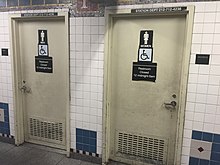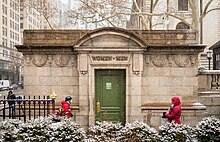Toilets in New York City
There are a number of bars in New York City, including McSorley's Old Ale House, that feature large vintage urinals.
During the mid-19th century, prior to the advent of indoor plumbing and flush toilets, buildings and homes were equipped with outhouses and chamber pots.
[8] In the late 19th century, many tenements in New York City, particularly on the Lower East Side, lacked toilets or running water.
[10][11][12] At that point, New York City's tenements had more than 9,000 privy vaults, euphemistically referred to as "school sinks", in their courtyards.
The school sinks were only flushed into the city's primitive sewerage system occasionally and were major vectors for diseases.
[15][16] The administration of mayor Eric Adams modified the city's building code in 2022 so that restaurants were no longer obligated to open their restrooms to the general public.
[24][25][26] Clyde Haberman wrote for The New York Times in 2000: "The fact remains that this is one of the few great world cities that make no attempt to help people cope with so basic a need, a situation that constantly amazes residents and visitors alike.
[30] A report by the Legal Action Center for the Homeless, who represented the plaintiffs, noted that of 526 public comfort stations surveyed in parks, almost three-quarters were "either closed, filthy, foul-smelling or without toilet paper and soap.
[32] The public bathrooms in Bryant Park, located between 40th and 42nd streets in Manhattan, are noted for their particular beauty and architectural significance.
A bathroom in Ferry Point Park in the Bronx cost $4.7 million in 2018 and, at the time, was the most expensive public restroom ever built in New York City.
[25] As of March 2024[update], a restroom under construction in Seaside Wildlife Nature Park in Staten Island is estimated to cost $6.8 million at completion.
When a $2.3 million public toilet opened at Elmhurst Park in Queens in 2012, community leader Robert Holden stated: "It's just a tremendous waste of space and, especially, money.
[40][41] Following a controversy over the cost of the Ferry Point Park bathroom, in 2019, the New York City government proposed constructing movable trailers with portable toilets to save money.
[42][43] Under the administration of mayor David Dinkins, French company JCDecaux placed several pay toilets across New York City in 1992.
[45] After a successful pilot of the toilets, in early 1993, the New York City Council mandated that JCDecaux provide a single design for handicapped and able-bodied users.
JCDecaux objected to the condition, saying that it wished to construct special toilets for handicapped users that required magnetic cards for access.
According to the partnership, the toilets were unsatisfactory for a variety of reasons including the 2-minute clean time between users, cost of maintenance, and declining of popularity.
[58] In 2005, as part of a $1 billion, 20-year agreement with Spanish company Cemusa, the firm planned to place 20 public toilets around New York City.
The bill directs a report to be prepared which identifies the currently available public bathrooms, and feasible locations for new ones in most Zip Code Tabulation Areas in the city.


